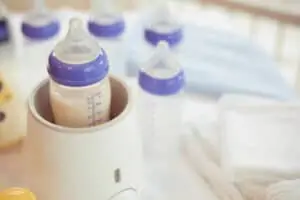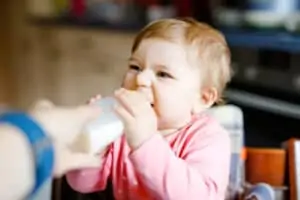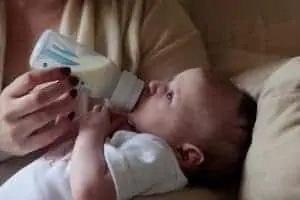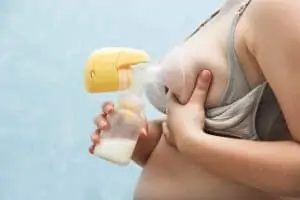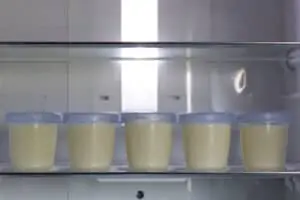My friend Kat was getting ready to go to a day spa, her first ever escape as a new mom from her baby without toting her precious bundle along. She had been looking forward to it for weeks, and finally, the day arrived. So too, did her mother-in-law, who had offered to come and care for little Rebecca while Kat was being pampered.
As her mother-in-law didn’t live quite as close as her own mother, she hadn’t been over as often. So when Kat saw her mother-in-law shaking the breast milk bottle, she nearly had a meltdown.
“I was told that you should never shake breast milk, and when I tried to tell her that, she laughed at me,” she had complained into the phone. Indeed, many people are arguing about shaking vs. swirling breast milk. It’s a topic that will divide people as greatly as politics.
But don’t worry, mamas, because I’m going to set the record straight about shaking vs. swirling breast milk so we can all just get along!
Why can’t you shake breast milk?
Let me be clear…you CAN shake breast milk. But you may not want to do so.
Breast milk is full of all kind of molecules that are meant to nourish your baby. Shaking that breast milk can denature these molecules, breaking up the proteins, which can make it hard on your baby’s developing gut.
Denatured proteins won’t serve their proper functions. BUT!
Ah, here’s that, but – some proteins, like those that are naturally in breast milk, are pretty tough to break down by shaking them. In fact, you’d have to be really aggressive about the whole thing and exert a ton of force.
This is why people have been saying swirling vs. shaking breast milk is the way to go when you’re giving your baby expressed breast milk. Since it separates, it needs to be mixed again.
So, if you slightly shake it by hand, you are really unlikely to cause any problems. But if you shake it up like crazy, there is a chance you could denature those proteins.
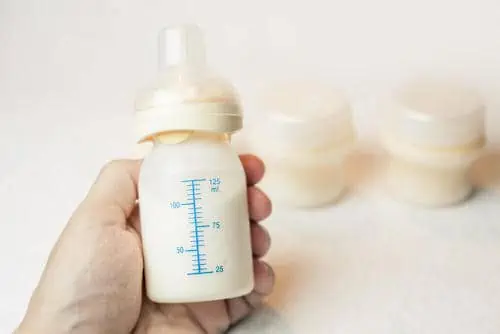
Since functional cells and proteins in milk need to be maintained for proper function, it’s easy to see why there is a such concern. But even a denatured protein is still good.
And, let’s think about this for a minute. When you pump your breast milk and pour it into the baby bottle, it agitates that milk, too, but it doesn’t break down the proteins or reduce the nutritional value.
When you shake breast milk, does it cause gas?
Now, here’s where you should be more concerned, especially if you feed a newborn expressed breast milk. Vigorously shaking that milk will bring more air into that milk. And we all know what happens when babies gulp down too much air, right?
If you’re new to the mom life, let me introduce you to a fun game called “Try Not to Let Baby Swallow Too Much Air or Gas Will Ruin Your Days and Nights.”
It won’t bother older babies whose digestion has further developed. But newborns are especially susceptible to this added air. If you have already had enough trouble with your baby crying and becoming gassy, you’ll want to avoid shaking that breast milk.
Does swirl or shake damage breast milk?
As I just mentioned, neither one really damages breast milk. You may want to avoid shaking up that breast milk while feeding a newborn, though, because that added air can make them gassy.
And gassy babies can make you even more tired as you try to calm them down.
What about cold breast milk?
Whether the breast milk is cold or at room temperature doesn’t matter. Remember that you should never leave breast milk out too long, or it can go bad. This will threaten your baby more than shake it a little.
Does shaking breast milk kill nutrients?
In most cases, shaking breast milk will not kill the nutrients unless you are shaking it with the kind of ferocity you’d use to turn heavy whipping cream into a whipped topping. However, you certainly don’t want a gassy baby, so it may be best to swirl it gently to mix the cream part that rose to the top all the way through for a more uniform feeding session.
Does breast milk bubble when shaken?
All milk – from humans or cows– gets bubbly when shaken, thanks to the protein or lipase in the milk. The more lipase there is, the more bubbly you can expect it to be. You may even notice it in your pumped bottles, particularly if your letdown is a bit forceful.
But don’t worry about that lipase because there is no evidence that a high content is bad for your baby. I’d be concerned that if your milk isn’t normally bubbly like this, your baby may not like the taste because it might be different. It certainly won’t harm your baby, though.
So, if you do shake the milk, do it gently and for older babies. For newborns and other small babies, I’d recommend swirling it gently to recombine it before feeding it to your baby. This way, you won’t have to worry about creating a gassy situation.
Leslie Berry lives with her husband and two young daughters in Los Altos, California, where she loves helping other moms get comfortable with motherhood and embracing the insanity with facts peppered with laughs.
She loves eating too much sushi, exercising, and jamming out on her Fender. Read more about Leslie here.

